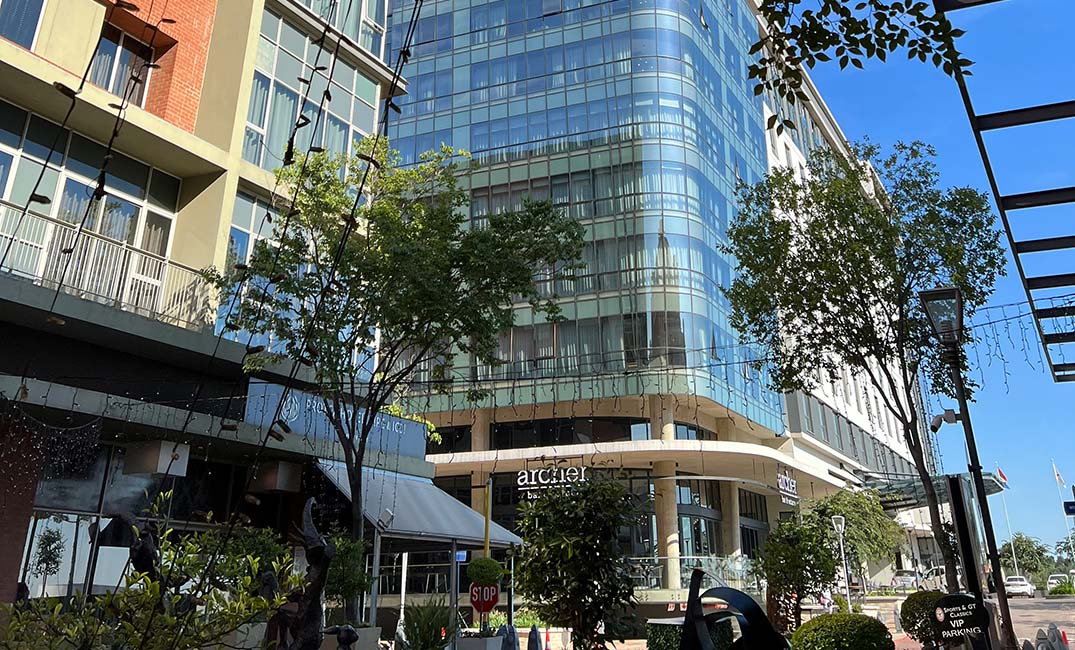As South Africa migrates to an off-grid economy, one mixed-use precinct is leading the way with its sustainable design.

Melrose Arch has a thriving waste separating facility, underground cooling plant, gardens and rooftop solar system, providing its hotels, businesses and residential properties with an unparalleled experience.
After blasting and bulk earthworks commenced in the year 1998, Melrose Arch opened with a limited upmarket facility, with phase 1 consisting of only 11 buildings in 2001.
It was constructed on a super basement that connects all areas of the precinct and remains the only one of this kind in the country. Parking cars in the basement reduces traffic congestion, and assists in reducing ambient air pollution above ground. Therefore, walking on street level is safe and pleasurable.
Known for its upmarket appeal and European street style aesthetic, Melrose Arch’s streets are lined with greenery. The precinct has over 700 trees planted within its border, as well as five internal garden spaces creating green lungs for residents and tenants to enjoy.
Melrose Arch has since expanded to house 106 000m² office space, 39 000m² retail space, 17 000m² hotel space, 29 000m² of residential and conferencing space, and 8600m² accommodating health clubs. The integration of sustainability operations has expanded parallel to the 199 600m², with the result of seamless integration.
Eco centre and waste separating facility
Melrose Arch’s waste separating facility, that operates 24/7 separates paper, cardboard, metals, plastics and glass, and sends these for recycling. At the property’s approximately 30 restaurants, cafés and bars on the precinct, food waste is separated at source, in the restaurant kitchens.
The food waste recycling works by implementing efficient waste separation methods and commitment, allowing each restaurant to divert food waste from traditional waste streams.
By separating the food waste at source, restaurants assist in thorough recycling and processing, transforming waste into valuable resources such as compost.
The food waste is taken offsite and directly to the Urban Farms Recycling Centre, where it is converted into organic fertiliser.
This organisation’s vermiculture facility in Modderfontein is the largest of its kind in South Africa. After the majority of the waste is recycled, the balance goes to a landfill, where the eco center aims to minimise the amount each day.
In February 2024, of the 92,578 tons of waste collected across the precinct, 88% was recycled. A total of 77 303,58m³ CO2, 712,447.19L of water and 312 494,50 kWh energy was saved.
Additionally, the eco centre creates employment and enhances community participation in climate-relevant mitigation and adaptation measures.
Cooling plant
The provision of efficient indoor climate and comfort, particularly in the offices and commercial buildings, has been prioritised since the inception of Melrose Arch’s development.
The precinct boasts its own 1 471m² district underground cooling plant, that operates 24/7. This remarkable facility includes 8 chillers that are 2 722,94kW in size, 12 cooling towers and five building water pumps.
Operated by a building management system, the plant is energy efficient. The cooling is centrally produced and distributes cold water to each building through a closed distribution network.
Environmentally-friendly and economically savvy, this center helps to regulate the temperature inside buildings across the entire precinct.
The cooling plant’s machinery and equipment have a nameplate capacity of 4 324,74KW, but for safety, are never operated at full capacity. The kVA demand for the plant during the summer months is set at 8,5kVA, which means that the plant regulates itself depending on demand, but it will limit itself to 8,5kVA. The average monthly kWh consumption for the plant is 494 914,08kWh.
Solar system
The Melrose Arch precinct’s rooftop solar system is intricately accommodated across 16 different roof surfaces, and every building under the precinct’s joint venture agreement that can host solar panels does.
Currently featuring 7 811 solar panels and multiple inverters, generating approximately 3,2MW of clean energy annually, the grid-tied system integrates with multiple generators during load-shedding.
Some of the commercial operators on the property such as the Johannesburg Marriott Hotel, Melrose Arch operate their own solar systems, providing further sustainability.
“We are committed to a target of 30% renewable energy across all of our properties by 2025, and becoming net zero for carbon emissions by 2050,” says Richard Collins, area vice-president: sub-Saharan Africa at Marriot International.
Melrose Arch is investigating the expansion of its current solar capacity, looking to increase its clean energy supply by a further 3MW per annum.
The precinct is also investigating a battery plant solution, tied into its own grid, to be powered by the solar plant, which will provide the precinct with up to four hours of standby energy in the event of outages.
Backup water
Melrose Arch has two sources of underground water. Through its water treatment plant, water is filtered and cleansed before being converted to potable water.
This water is channeled to Melrose Arch’s standby tanks, which are in place to enable the precinct to continue to enjoy water when there are interruptions to the local supply.
The water system keeps the precinct’s gardens green throughout the year and ensures that less water is wasted. Last year alone, the precinct saved 3,5-million litres of water in this way.
In addition, Melrose Arch has a water backup system with sufficient supply to keep operations flowing for up to 72 hours at any given time.
“Melrose Arch’s prominence in the commercial and residential sector is underpinned by its robust operational sustainability integration that includes solar power, waste separation, a cooling plant, water backup and more,” says Reiner Henschel, operations director at Melrose Arch.
“However, our commitment doesn’t end there. We are resolute in continually integrating sustainability into our operations, ensuring that the precinct maintains its position as a leader in environmental responsibility in South Africa,” he concludes.
